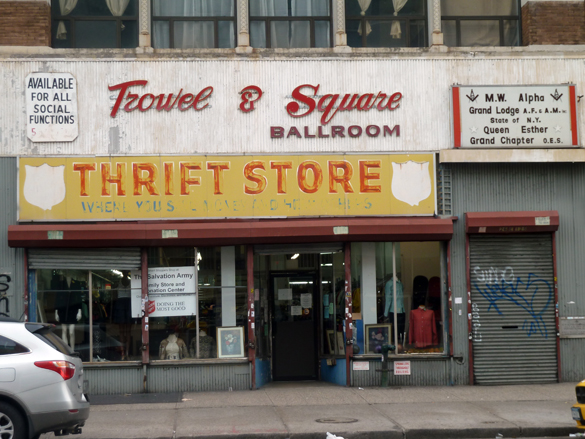
Selfie © Frank H. Jump

Daniel Roberts in front of Miss Weber’s Millinery – Flatiron © Frank H. Jump

Steed Taylor in front of Griffon Shears – Chelsea © Frank H. Jump

John Kelly in front of Society Smokes Cigar – Midtown © Frank H. Jump
Not much was known about AIDS when I became infected with HIV in 1984. Upon receiving my diagnosis, I was told I would most likely be dead by 1990. In 1997, when I started documenting what I called fading ads– hand-painted vintage wall advertisements, many of which have long outlived the products they advertise- I had already well outlived my prognosis. Today at 53, I have become a living advertisement for a disease that seems to have lost its exigency in the public light.
As this project has matured and I have become a long-term survivor, the original metaphor of the Fading Ad Campaign that rang true for me fifteen years ago still resounds, but the overtones have modulated. Although I continue to utilize these images to draw light upon the fading problem of AIDS, fostering awareness isn’t the primary focus anymore as is the condition of the aging survivors, many of whom have lost their fear of dying from AIDS but are succumbing to age-related illnesses and complications from pharmacological toxicities. Through this campaign, my life mission is to continue to shed light on this lingering issue that still affects many of us in the LGBTQ community.
According to a study conducted in 2006 by the AIDS Community Research Initiative of America for the New York City Department of Health and Mental Hygiene, of the one hundred thousand HIV+ people living in NYC, thirty percent are over age fifty and seventy percent are over forty. Coupled with the living with HIV and the comorbidities of aging, the health care system is ill-prepared for what is to come in the next decade and according to this study, “there is little research and even less acknowledgment or foresight anticipating this consequential commingling of HIV and aging comorbidities.”
After fifteen years of developing this project, the metaphor of survival has become more profound since I never expected to live into my fifties with this virus. Others in the LGBTQ community who are living with HIV into their later years are equally challenged by aging and navigating through a rapidly changing city. As our urban landscape continues to radically change, our memories of the city and of our bodies in the city becomes truncated and distorted as the arc of time bends and our perception of time begins to accelerate. Of the thousands of ads I’ve photographed, many have faded out of existence, been covered over or destroyed with entire city blocks having been demolished and replaced by new shiny glass and metal buildings. But still many fading ads silently cling to the walls of buildings, barely noticed by the rushing passersby.
It is my plan to use a representative selection from the Fading Ad Campaign as a backdrop to create new portraits with members of the surviving HIV+ community in NYC, many who are also visual artists. I also plan to work with Visual AIDS to organize interviews and portrait shots with these artists. Additionally, I am collaborating with a social worker from Mount Sinai who works with LGBT elders with HIV who are struggling to maintain their dignity and their gay identities in all aspects of the healthcare system. Many LGBT elders with HIV have lived their lives publicly but since they are now dependent upon home care workers who may not be sympathetic to their identities, they find themselves going back into the closet, clinging silently like a fading ad on a northern exposure, hoping not to be noticed.
These new images juxtaposed with the 35mm chrome shots I took fifteen years ago will provide a narrative of the challenges LGBT elders with HIV face, yet also provide a sense of purpose and validation at a time in their lives that seems uncertain. These portraits of our community against the backdrop of the city and the fading ads will become a document of this time framed by both the past and future. – Frank H. Jump, December 1, 2013




























